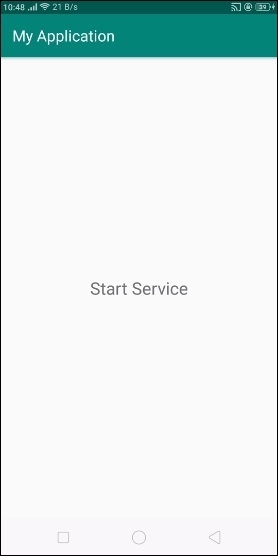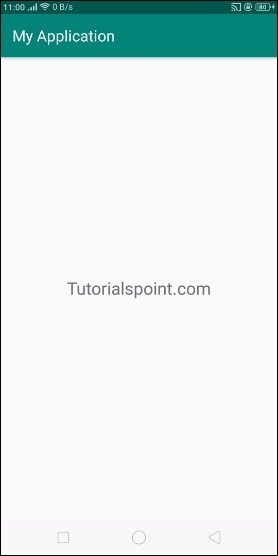
 Data Structure
Data Structure Networking
Networking RDBMS
RDBMS Operating System
Operating System Java
Java MS Excel
MS Excel iOS
iOS HTML
HTML CSS
CSS Android
Android Python
Python C Programming
C Programming C++
C++ C#
C# MongoDB
MongoDB MySQL
MySQL Javascript
Javascript PHP
PHP
- Selected Reading
- UPSC IAS Exams Notes
- Developer's Best Practices
- Questions and Answers
- Effective Resume Writing
- HR Interview Questions
- Computer Glossary
- Who is Who
Android stop specified IntentService?
Before getting into the example, we should know what Intent service is in android. Intent Service is going to do background operation asynchronously. When user call startService() from activity, it doesn’t create the instance for each request and it going to stop service after done some action in service class or else we need to stop service manually by using stopSelf().
This example demonstrates about Android stop specified IntentService.
Step 1 − Create a new project in Android Studio, go to File ⇒ New Project and fill all required details to create a new project.
Step 2 − Add the following code to res/layout/activity_main.xml.
<?xml version = "1.0" encoding = "utf-8"?>
<android.support.constraint.ConstraintLayout xmlns:android = "http://schemas.android.com/apk/res/android"
xmlns:app = "http://schemas.android.com/apk/res-auto"
xmlns:tools = "http://schemas.android.com/tools"
android:layout_width = "match_parent"
android:layout_height = "match_parent"
tools:context = ".MainActivity">
<TextView
android:id = "@+id/text"
android:layout_width = "wrap_content"
android:layout_height = "wrap_content"
android:text = "Start Service"
android:textSize = "25sp"
app:layout_constraintBottom_toBottomOf = "parent"
app:layout_constraintLeft_toLeftOf = "parent"
app:layout_constraintRight_toRightOf = "parent"
app:layout_constraintTop_toTopOf = "parent" />
</android.support.constraint.ConstraintLayout>
In the above code, we have taken text view, when the user gets the data from intent service it will update.
Step 3 − Add the following code to src/MainActivity.java
package com.example.andy.myapplication;
import android.content.BroadcastReceiver;
import android.content.Context;
import android.content.Intent;
import android.content.IntentFilter;
import android.os.Bundle;
import android.support.v7.app.AppCompatActivity;
import android.view.View;
import android.widget.TextView;
public class MainActivity extends AppCompatActivity {
TextView text;
BroadcastReceiver broadcastReceiver = new BroadcastReceiver() {
@Override
public void onReceive(Context context, Intent intent) {
String s1 = intent.getStringExtra("DATAPASSED");
text.setText(s1);
}
};
@Override
protected void onStart() {
super.onStart();
IntentFilter intentFilter = new IntentFilter();
intentFilter.addAction("com.example.andy.myapplication");
registerReceiver(broadcastReceiver, intentFilter);
}
@Override
protected void onCreate(Bundle savedInstanceState) {
super.onCreate(savedInstanceState);
setContentView(R.layout.activity_main);
text = findViewById(R.id.text);
text.setOnClickListener(new View.OnClickListener() {
@Override
public void onClick(View v) {
startService(new Intent(MainActivity.this, service.class));
}
});
}
@Override
protected void onStop() {
super.onStop();
unregisterReceiver(broadcastReceiver);
}
}
In the above code, we have created a service class and dynamic broadcast receiver as shown below –
@Override
protected void onStart() {
super.onStart();
IntentFilter intentFilter = new IntentFilter();
intentFilter.addAction("com.example.andy.myapplication");
registerReceiver(broadcastReceiver, intentFilter);
}
…………………………………………..
BroadcastReceiver broadcastReceiver = new BroadcastReceiver() {
@Override
public void onReceive(Context context, Intent intent) {
String s1 = intent.getStringExtra("DATAPASSED");
text.setText(s1);
}
};
…………………………………………………………………………..
@Override
protected void onStop() {
super.onStop();
unregisterReceiver(broadcastReceiver);
}
Create a class called service.class file and add the following code –
package com.example.andy.myapplication;
import android.app.IntentService;
import android.content.Intent;
import android.os.IBinder;
public class service extends IntentService {
public static volatile boolean shouldStop = false;
public service() {
super(service.class.getSimpleName());
}
@Override
public IBinder onBind(Intent intent) {
return null;
}
@Override
protected void onHandleIntent(Intent intent) {
Intent intent1 = new Intent();
intent1.setAction("com.example.andy.myapplication");
intent1.putExtra("DATAPASSED", "Tutorialspoint.com");
sendBroadcast(intent1);
if(shouldStop) {
stopSelf();
return;
}
}
}
To stop service, User the following code in service class –
stopSelf();
Step 4 − Add the following code to manifest.xml
<?xml version = "1.0" encoding = "utf-8"?> <manifest xmlns:android = "http://schemas.android.com/apk/res/android" package = "com.example.andy.myapplication"> <uses-permission android:name = "android.permission.WAKE_LOCK"/> <application android:allowBackup = "true" android:icon = "@mipmap/ic_launcher" android:label = "@string/app_name" android:roundIcon = "@mipmap/ic_launcher_round" android:supportsRtl = "true" android:theme = "@style/AppTheme"> <activity android:name = ".MainActivity"> <intent-filter> <action android:name = "android.intent.action.MAIN" /> <category android:name = "android.intent.category.LAUNCHER" /> </intent-filter> </activity> <service android:name = ".service"/> </application> </manifest>
Let's try to run your application. I assume you have connected your actual Android Mobile device with your computer. To run the app from the android studio, open one of your project's activity files and click the Run icon![]() from the toolbar. Select your mobile device as an option and then check your mobile device which will display your default screen –
from the toolbar. Select your mobile device as an option and then check your mobile device which will display your default screen –

In the above result, it has shown the default screen of an application. When user click on “Start Service” it will start service and update the textview as shown below-

After sending the broadcast to mainactvity, it will stop the intent service.
Click here to download the project code

